Factors in public health PDF
VerifiedAdded on 2022/01/07
|9
|2543
|20
AI Summary
Contribute Materials
Your contribution can guide someone’s learning journey. Share your
documents today.
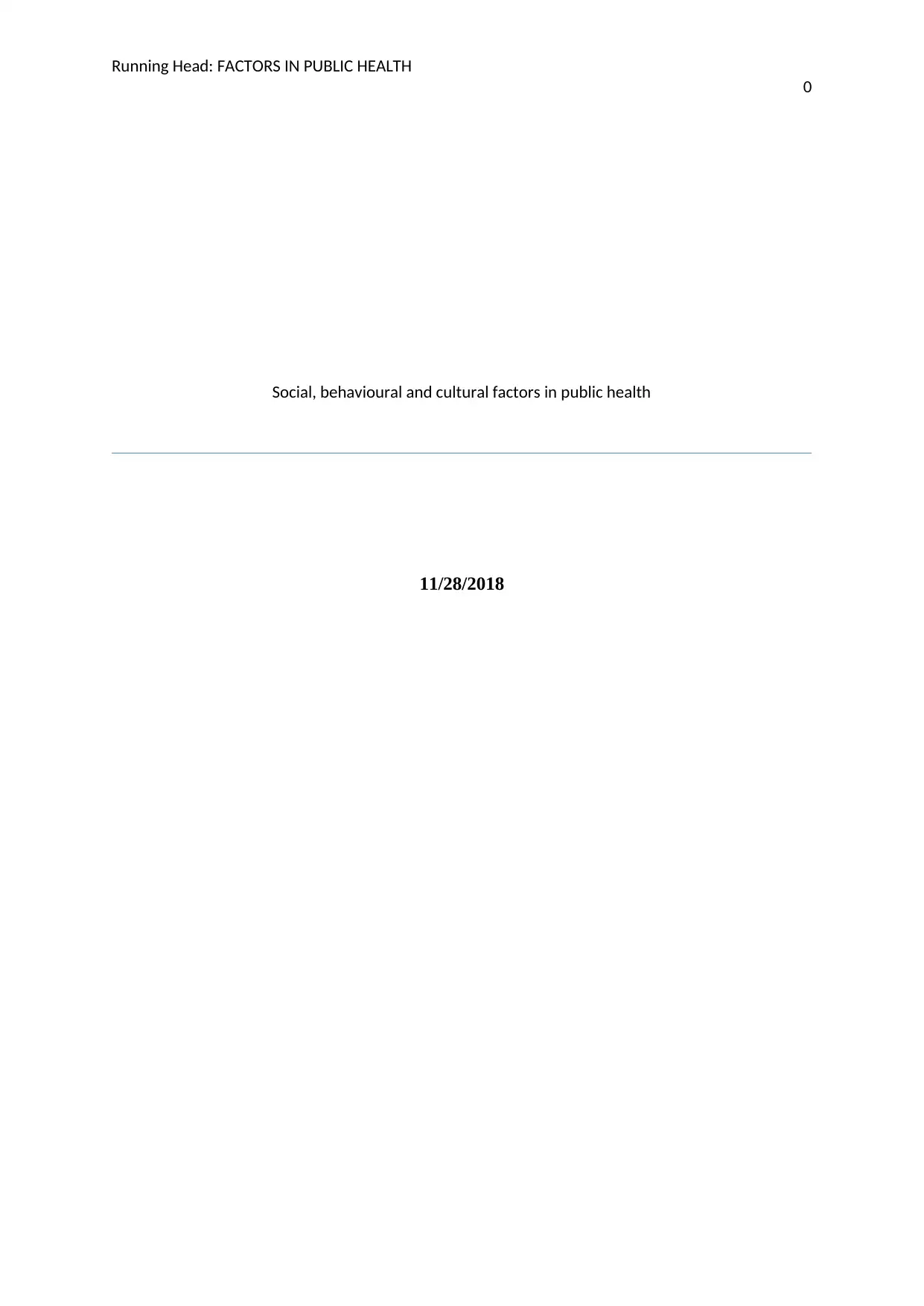
Running Head: FACTORS IN PUBLIC HEALTH
0
Social, behavioural and cultural factors in public health
11/28/2018
0
Social, behavioural and cultural factors in public health
11/28/2018
Secure Best Marks with AI Grader
Need help grading? Try our AI Grader for instant feedback on your assignments.
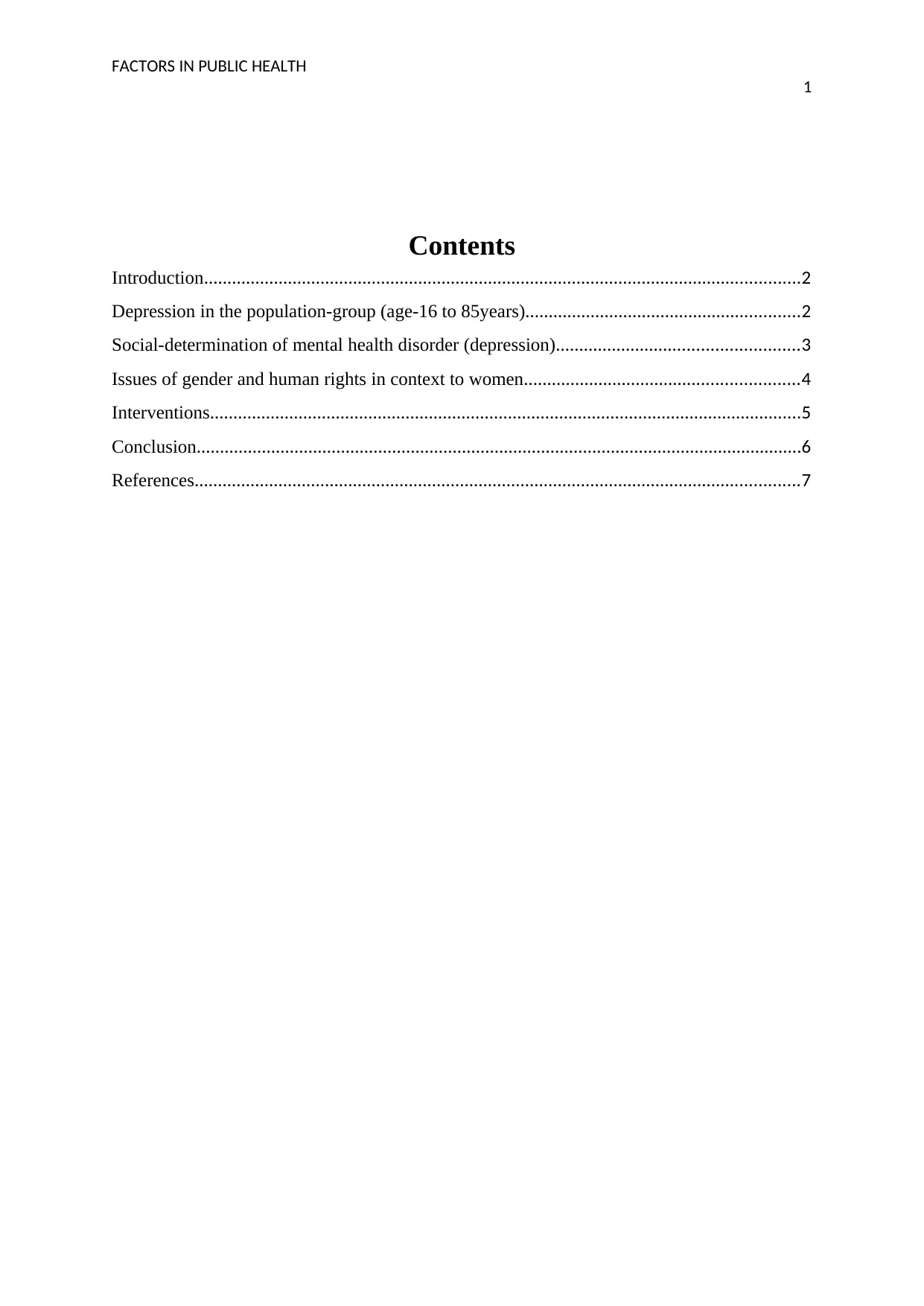
FACTORS IN PUBLIC HEALTH
1
Contents
Introduction................................................................................................................................2
Depression in the population-group (age-16 to 85years)...........................................................2
Social-determination of mental health disorder (depression)....................................................3
Issues of gender and human rights in context to women...........................................................4
Interventions...............................................................................................................................5
Conclusion..................................................................................................................................6
References..................................................................................................................................7
1
Contents
Introduction................................................................................................................................2
Depression in the population-group (age-16 to 85years)...........................................................2
Social-determination of mental health disorder (depression)....................................................3
Issues of gender and human rights in context to women...........................................................4
Interventions...............................................................................................................................5
Conclusion..................................................................................................................................6
References..................................................................................................................................7
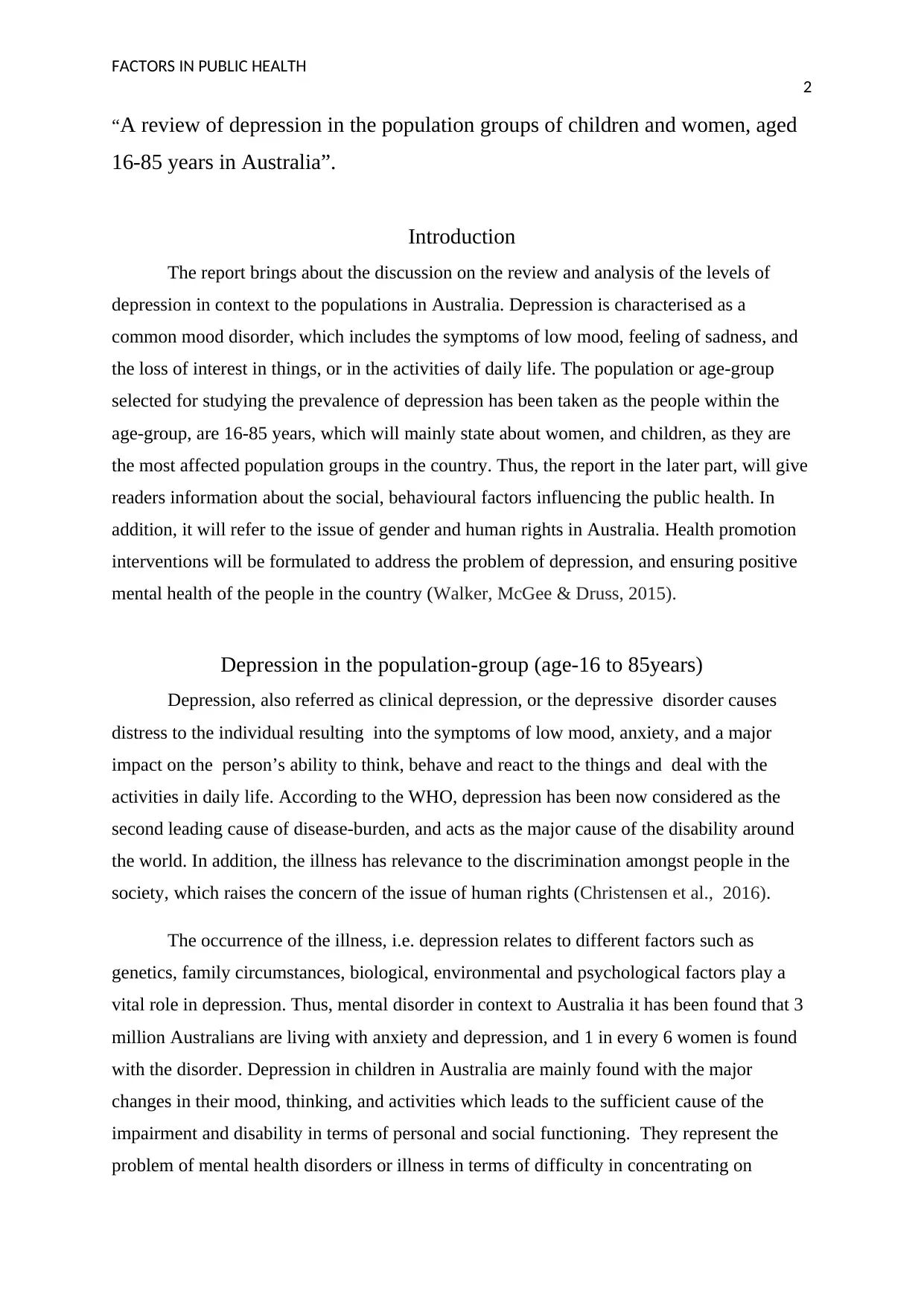
FACTORS IN PUBLIC HEALTH
2
“A review of depression in the population groups of children and women, aged
16-85 years in Australia”.
Introduction
The report brings about the discussion on the review and analysis of the levels of
depression in context to the populations in Australia. Depression is characterised as a
common mood disorder, which includes the symptoms of low mood, feeling of sadness, and
the loss of interest in things, or in the activities of daily life. The population or age-group
selected for studying the prevalence of depression has been taken as the people within the
age-group, are 16-85 years, which will mainly state about women, and children, as they are
the most affected population groups in the country. Thus, the report in the later part, will give
readers information about the social, behavioural factors influencing the public health. In
addition, it will refer to the issue of gender and human rights in Australia. Health promotion
interventions will be formulated to address the problem of depression, and ensuring positive
mental health of the people in the country (Walker, McGee & Druss, 2015).
Depression in the population-group (age-16 to 85years)
Depression, also referred as clinical depression, or the depressive disorder causes
distress to the individual resulting into the symptoms of low mood, anxiety, and a major
impact on the person’s ability to think, behave and react to the things and deal with the
activities in daily life. According to the WHO, depression has been now considered as the
second leading cause of disease-burden, and acts as the major cause of the disability around
the world. In addition, the illness has relevance to the discrimination amongst people in the
society, which raises the concern of the issue of human rights (Christensen et al., 2016).
The occurrence of the illness, i.e. depression relates to different factors such as
genetics, family circumstances, biological, environmental and psychological factors play a
vital role in depression. Thus, mental disorder in context to Australia it has been found that 3
million Australians are living with anxiety and depression, and 1 in every 6 women is found
with the disorder. Depression in children in Australia are mainly found with the major
changes in their mood, thinking, and activities which leads to the sufficient cause of the
impairment and disability in terms of personal and social functioning. They represent the
problem of mental health disorders or illness in terms of difficulty in concentrating on
2
“A review of depression in the population groups of children and women, aged
16-85 years in Australia”.
Introduction
The report brings about the discussion on the review and analysis of the levels of
depression in context to the populations in Australia. Depression is characterised as a
common mood disorder, which includes the symptoms of low mood, feeling of sadness, and
the loss of interest in things, or in the activities of daily life. The population or age-group
selected for studying the prevalence of depression has been taken as the people within the
age-group, are 16-85 years, which will mainly state about women, and children, as they are
the most affected population groups in the country. Thus, the report in the later part, will give
readers information about the social, behavioural factors influencing the public health. In
addition, it will refer to the issue of gender and human rights in Australia. Health promotion
interventions will be formulated to address the problem of depression, and ensuring positive
mental health of the people in the country (Walker, McGee & Druss, 2015).
Depression in the population-group (age-16 to 85years)
Depression, also referred as clinical depression, or the depressive disorder causes
distress to the individual resulting into the symptoms of low mood, anxiety, and a major
impact on the person’s ability to think, behave and react to the things and deal with the
activities in daily life. According to the WHO, depression has been now considered as the
second leading cause of disease-burden, and acts as the major cause of the disability around
the world. In addition, the illness has relevance to the discrimination amongst people in the
society, which raises the concern of the issue of human rights (Christensen et al., 2016).
The occurrence of the illness, i.e. depression relates to different factors such as
genetics, family circumstances, biological, environmental and psychological factors play a
vital role in depression. Thus, mental disorder in context to Australia it has been found that 3
million Australians are living with anxiety and depression, and 1 in every 6 women is found
with the disorder. Depression in children in Australia are mainly found with the major
changes in their mood, thinking, and activities which leads to the sufficient cause of the
impairment and disability in terms of personal and social functioning. They represent the
problem of mental health disorders or illness in terms of difficulty in concentrating on
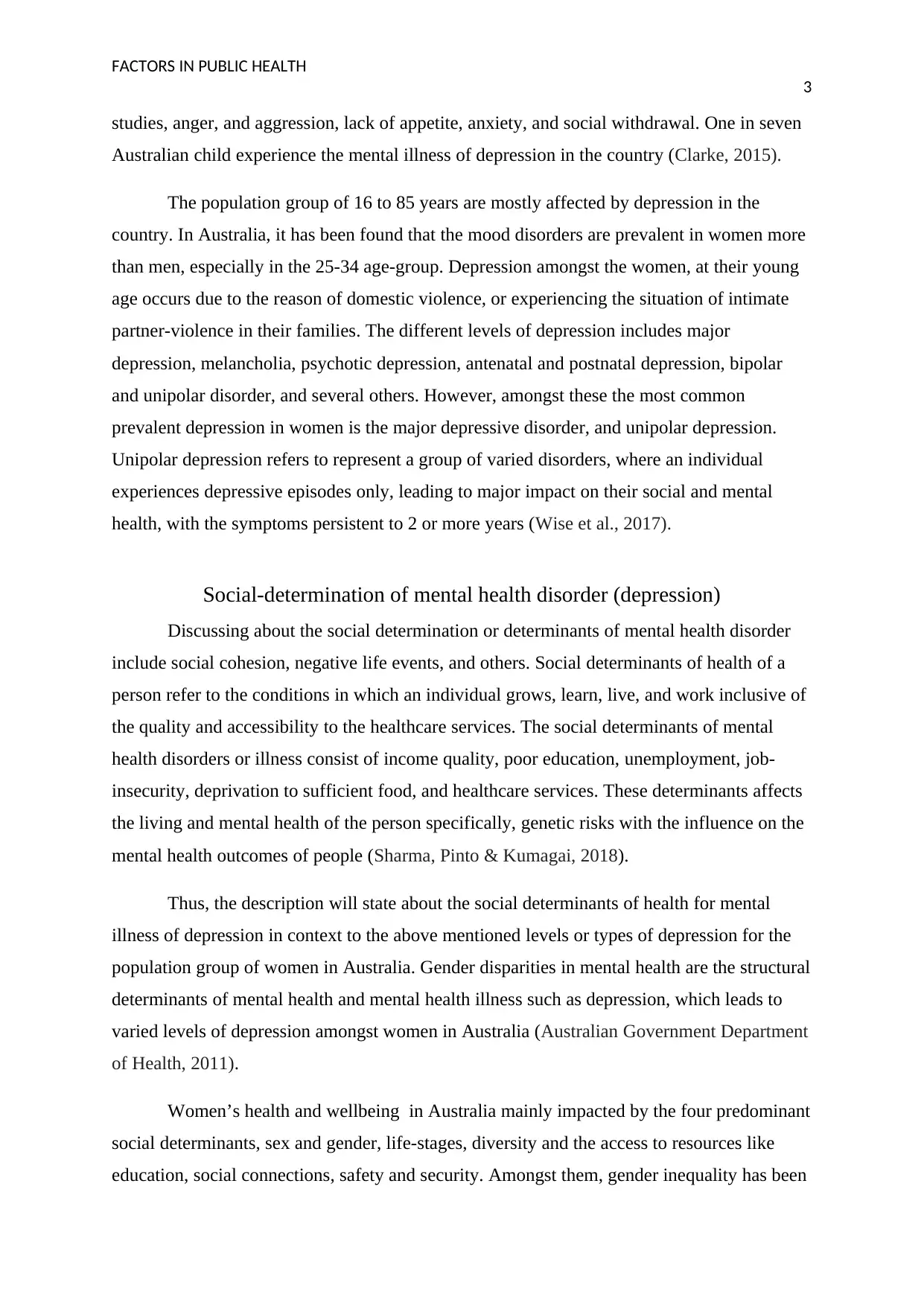
FACTORS IN PUBLIC HEALTH
3
studies, anger, and aggression, lack of appetite, anxiety, and social withdrawal. One in seven
Australian child experience the mental illness of depression in the country (Clarke, 2015).
The population group of 16 to 85 years are mostly affected by depression in the
country. In Australia, it has been found that the mood disorders are prevalent in women more
than men, especially in the 25-34 age-group. Depression amongst the women, at their young
age occurs due to the reason of domestic violence, or experiencing the situation of intimate
partner-violence in their families. The different levels of depression includes major
depression, melancholia, psychotic depression, antenatal and postnatal depression, bipolar
and unipolar disorder, and several others. However, amongst these the most common
prevalent depression in women is the major depressive disorder, and unipolar depression.
Unipolar depression refers to represent a group of varied disorders, where an individual
experiences depressive episodes only, leading to major impact on their social and mental
health, with the symptoms persistent to 2 or more years (Wise et al., 2017).
Social-determination of mental health disorder (depression)
Discussing about the social determination or determinants of mental health disorder
include social cohesion, negative life events, and others. Social determinants of health of a
person refer to the conditions in which an individual grows, learn, live, and work inclusive of
the quality and accessibility to the healthcare services. The social determinants of mental
health disorders or illness consist of income quality, poor education, unemployment, job-
insecurity, deprivation to sufficient food, and healthcare services. These determinants affects
the living and mental health of the person specifically, genetic risks with the influence on the
mental health outcomes of people (Sharma, Pinto & Kumagai, 2018).
Thus, the description will state about the social determinants of health for mental
illness of depression in context to the above mentioned levels or types of depression for the
population group of women in Australia. Gender disparities in mental health are the structural
determinants of mental health and mental health illness such as depression, which leads to
varied levels of depression amongst women in Australia (Australian Government Department
of Health, 2011).
Women’s health and wellbeing in Australia mainly impacted by the four predominant
social determinants, sex and gender, life-stages, diversity and the access to resources like
education, social connections, safety and security. Amongst them, gender inequality has been
3
studies, anger, and aggression, lack of appetite, anxiety, and social withdrawal. One in seven
Australian child experience the mental illness of depression in the country (Clarke, 2015).
The population group of 16 to 85 years are mostly affected by depression in the
country. In Australia, it has been found that the mood disorders are prevalent in women more
than men, especially in the 25-34 age-group. Depression amongst the women, at their young
age occurs due to the reason of domestic violence, or experiencing the situation of intimate
partner-violence in their families. The different levels of depression includes major
depression, melancholia, psychotic depression, antenatal and postnatal depression, bipolar
and unipolar disorder, and several others. However, amongst these the most common
prevalent depression in women is the major depressive disorder, and unipolar depression.
Unipolar depression refers to represent a group of varied disorders, where an individual
experiences depressive episodes only, leading to major impact on their social and mental
health, with the symptoms persistent to 2 or more years (Wise et al., 2017).
Social-determination of mental health disorder (depression)
Discussing about the social determination or determinants of mental health disorder
include social cohesion, negative life events, and others. Social determinants of health of a
person refer to the conditions in which an individual grows, learn, live, and work inclusive of
the quality and accessibility to the healthcare services. The social determinants of mental
health disorders or illness consist of income quality, poor education, unemployment, job-
insecurity, deprivation to sufficient food, and healthcare services. These determinants affects
the living and mental health of the person specifically, genetic risks with the influence on the
mental health outcomes of people (Sharma, Pinto & Kumagai, 2018).
Thus, the description will state about the social determinants of health for mental
illness of depression in context to the above mentioned levels or types of depression for the
population group of women in Australia. Gender disparities in mental health are the structural
determinants of mental health and mental health illness such as depression, which leads to
varied levels of depression amongst women in Australia (Australian Government Department
of Health, 2011).
Women’s health and wellbeing in Australia mainly impacted by the four predominant
social determinants, sex and gender, life-stages, diversity and the access to resources like
education, social connections, safety and security. Amongst them, gender inequality has been
Secure Best Marks with AI Grader
Need help grading? Try our AI Grader for instant feedback on your assignments.
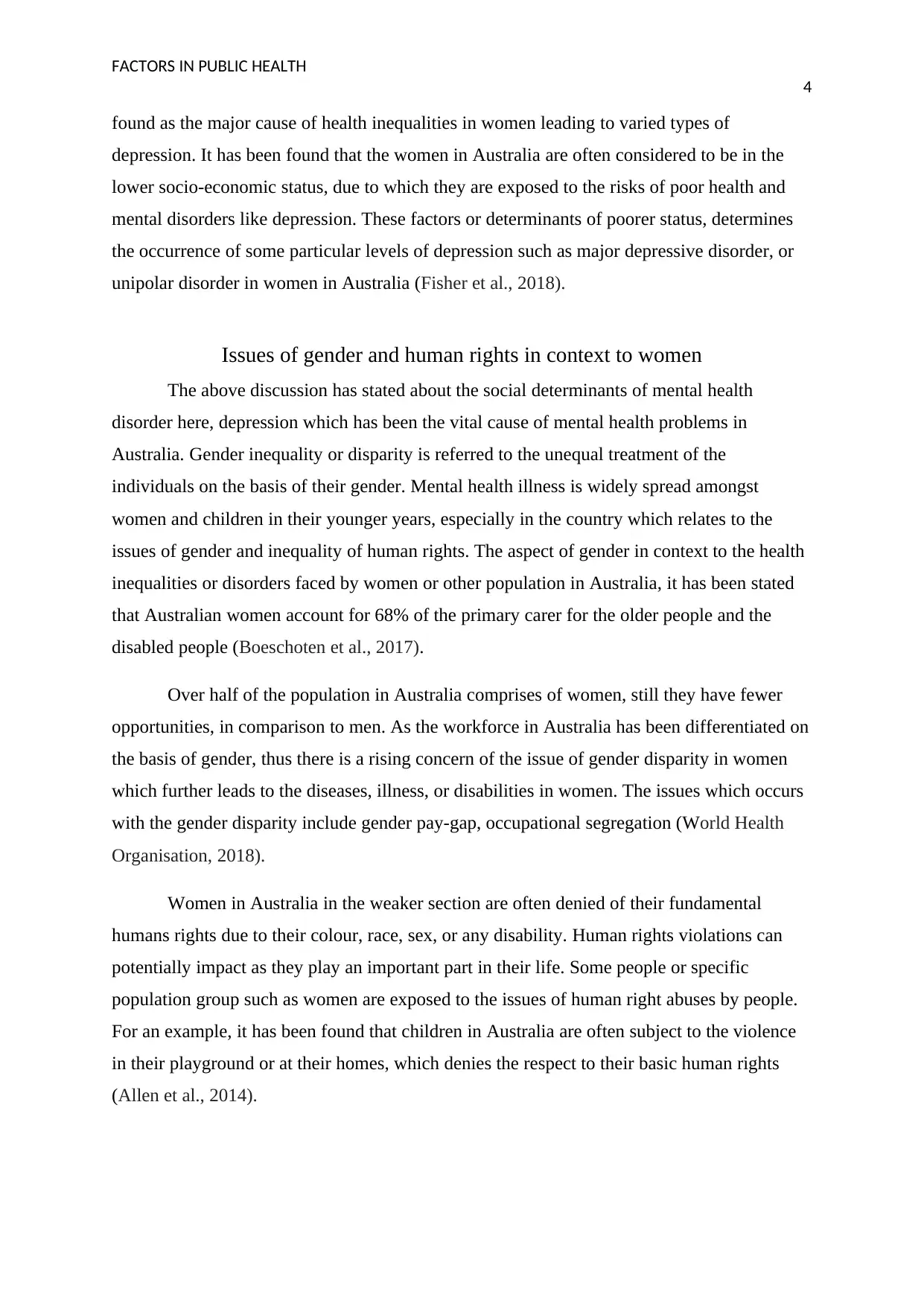
FACTORS IN PUBLIC HEALTH
4
found as the major cause of health inequalities in women leading to varied types of
depression. It has been found that the women in Australia are often considered to be in the
lower socio-economic status, due to which they are exposed to the risks of poor health and
mental disorders like depression. These factors or determinants of poorer status, determines
the occurrence of some particular levels of depression such as major depressive disorder, or
unipolar disorder in women in Australia (Fisher et al., 2018).
Issues of gender and human rights in context to women
The above discussion has stated about the social determinants of mental health
disorder here, depression which has been the vital cause of mental health problems in
Australia. Gender inequality or disparity is referred to the unequal treatment of the
individuals on the basis of their gender. Mental health illness is widely spread amongst
women and children in their younger years, especially in the country which relates to the
issues of gender and inequality of human rights. The aspect of gender in context to the health
inequalities or disorders faced by women or other population in Australia, it has been stated
that Australian women account for 68% of the primary carer for the older people and the
disabled people (Boeschoten et al., 2017).
Over half of the population in Australia comprises of women, still they have fewer
opportunities, in comparison to men. As the workforce in Australia has been differentiated on
the basis of gender, thus there is a rising concern of the issue of gender disparity in women
which further leads to the diseases, illness, or disabilities in women. The issues which occurs
with the gender disparity include gender pay-gap, occupational segregation (World Health
Organisation, 2018).
Women in Australia in the weaker section are often denied of their fundamental
humans rights due to their colour, race, sex, or any disability. Human rights violations can
potentially impact as they play an important part in their life. Some people or specific
population group such as women are exposed to the issues of human right abuses by people.
For an example, it has been found that children in Australia are often subject to the violence
in their playground or at their homes, which denies the respect to their basic human rights
(Allen et al., 2014).
4
found as the major cause of health inequalities in women leading to varied types of
depression. It has been found that the women in Australia are often considered to be in the
lower socio-economic status, due to which they are exposed to the risks of poor health and
mental disorders like depression. These factors or determinants of poorer status, determines
the occurrence of some particular levels of depression such as major depressive disorder, or
unipolar disorder in women in Australia (Fisher et al., 2018).
Issues of gender and human rights in context to women
The above discussion has stated about the social determinants of mental health
disorder here, depression which has been the vital cause of mental health problems in
Australia. Gender inequality or disparity is referred to the unequal treatment of the
individuals on the basis of their gender. Mental health illness is widely spread amongst
women and children in their younger years, especially in the country which relates to the
issues of gender and inequality of human rights. The aspect of gender in context to the health
inequalities or disorders faced by women or other population in Australia, it has been stated
that Australian women account for 68% of the primary carer for the older people and the
disabled people (Boeschoten et al., 2017).
Over half of the population in Australia comprises of women, still they have fewer
opportunities, in comparison to men. As the workforce in Australia has been differentiated on
the basis of gender, thus there is a rising concern of the issue of gender disparity in women
which further leads to the diseases, illness, or disabilities in women. The issues which occurs
with the gender disparity include gender pay-gap, occupational segregation (World Health
Organisation, 2018).
Women in Australia in the weaker section are often denied of their fundamental
humans rights due to their colour, race, sex, or any disability. Human rights violations can
potentially impact as they play an important part in their life. Some people or specific
population group such as women are exposed to the issues of human right abuses by people.
For an example, it has been found that children in Australia are often subject to the violence
in their playground or at their homes, which denies the respect to their basic human rights
(Allen et al., 2014).
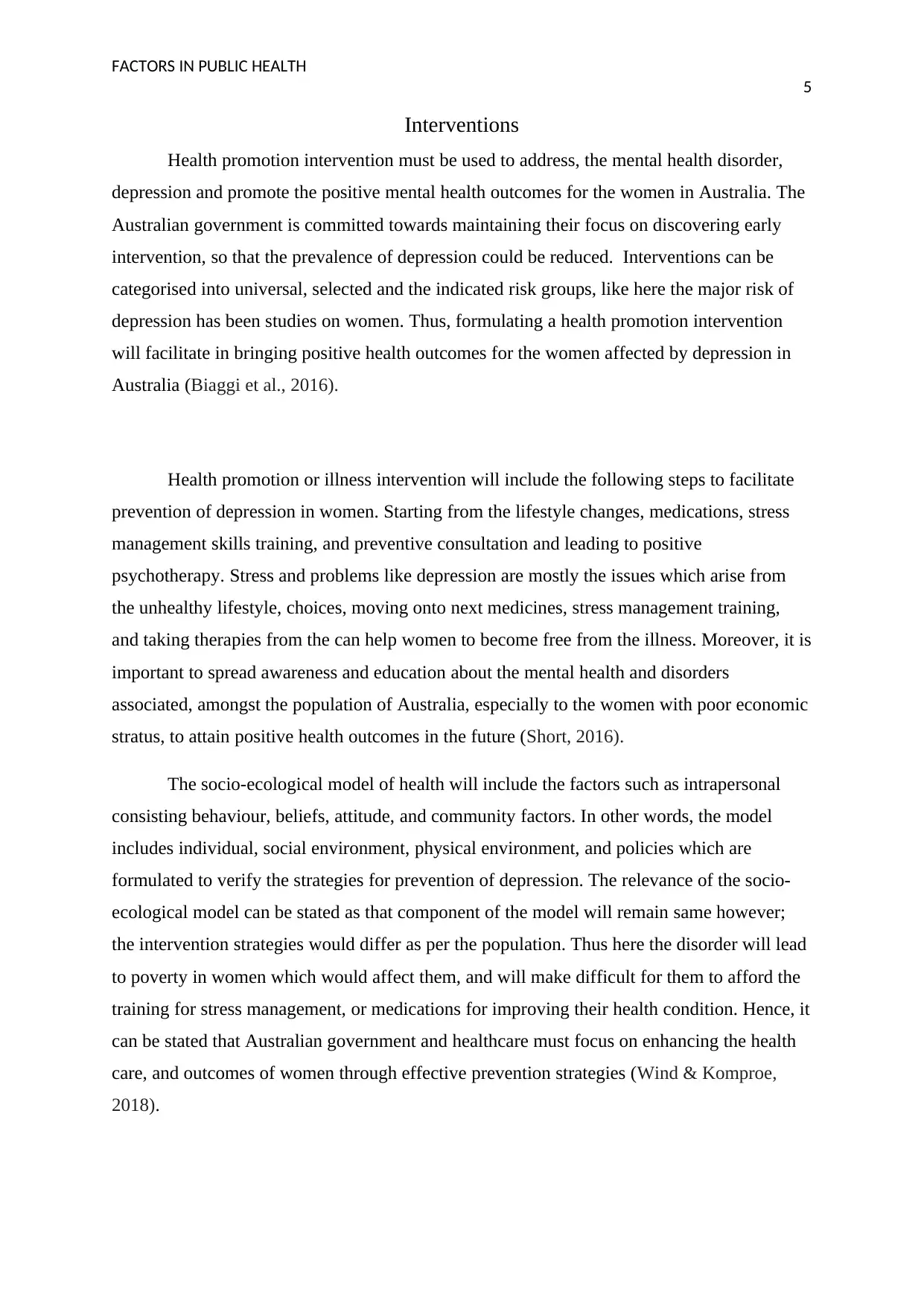
FACTORS IN PUBLIC HEALTH
5
Interventions
Health promotion intervention must be used to address, the mental health disorder,
depression and promote the positive mental health outcomes for the women in Australia. The
Australian government is committed towards maintaining their focus on discovering early
intervention, so that the prevalence of depression could be reduced. Interventions can be
categorised into universal, selected and the indicated risk groups, like here the major risk of
depression has been studies on women. Thus, formulating a health promotion intervention
will facilitate in bringing positive health outcomes for the women affected by depression in
Australia (Biaggi et al., 2016).
Health promotion or illness intervention will include the following steps to facilitate
prevention of depression in women. Starting from the lifestyle changes, medications, stress
management skills training, and preventive consultation and leading to positive
psychotherapy. Stress and problems like depression are mostly the issues which arise from
the unhealthy lifestyle, choices, moving onto next medicines, stress management training,
and taking therapies from the can help women to become free from the illness. Moreover, it is
important to spread awareness and education about the mental health and disorders
associated, amongst the population of Australia, especially to the women with poor economic
stratus, to attain positive health outcomes in the future (Short, 2016).
The socio-ecological model of health will include the factors such as intrapersonal
consisting behaviour, beliefs, attitude, and community factors. In other words, the model
includes individual, social environment, physical environment, and policies which are
formulated to verify the strategies for prevention of depression. The relevance of the socio-
ecological model can be stated as that component of the model will remain same however;
the intervention strategies would differ as per the population. Thus here the disorder will lead
to poverty in women which would affect them, and will make difficult for them to afford the
training for stress management, or medications for improving their health condition. Hence, it
can be stated that Australian government and healthcare must focus on enhancing the health
care, and outcomes of women through effective prevention strategies (Wind & Komproe,
2018).
5
Interventions
Health promotion intervention must be used to address, the mental health disorder,
depression and promote the positive mental health outcomes for the women in Australia. The
Australian government is committed towards maintaining their focus on discovering early
intervention, so that the prevalence of depression could be reduced. Interventions can be
categorised into universal, selected and the indicated risk groups, like here the major risk of
depression has been studies on women. Thus, formulating a health promotion intervention
will facilitate in bringing positive health outcomes for the women affected by depression in
Australia (Biaggi et al., 2016).
Health promotion or illness intervention will include the following steps to facilitate
prevention of depression in women. Starting from the lifestyle changes, medications, stress
management skills training, and preventive consultation and leading to positive
psychotherapy. Stress and problems like depression are mostly the issues which arise from
the unhealthy lifestyle, choices, moving onto next medicines, stress management training,
and taking therapies from the can help women to become free from the illness. Moreover, it is
important to spread awareness and education about the mental health and disorders
associated, amongst the population of Australia, especially to the women with poor economic
stratus, to attain positive health outcomes in the future (Short, 2016).
The socio-ecological model of health will include the factors such as intrapersonal
consisting behaviour, beliefs, attitude, and community factors. In other words, the model
includes individual, social environment, physical environment, and policies which are
formulated to verify the strategies for prevention of depression. The relevance of the socio-
ecological model can be stated as that component of the model will remain same however;
the intervention strategies would differ as per the population. Thus here the disorder will lead
to poverty in women which would affect them, and will make difficult for them to afford the
training for stress management, or medications for improving their health condition. Hence, it
can be stated that Australian government and healthcare must focus on enhancing the health
care, and outcomes of women through effective prevention strategies (Wind & Komproe,
2018).
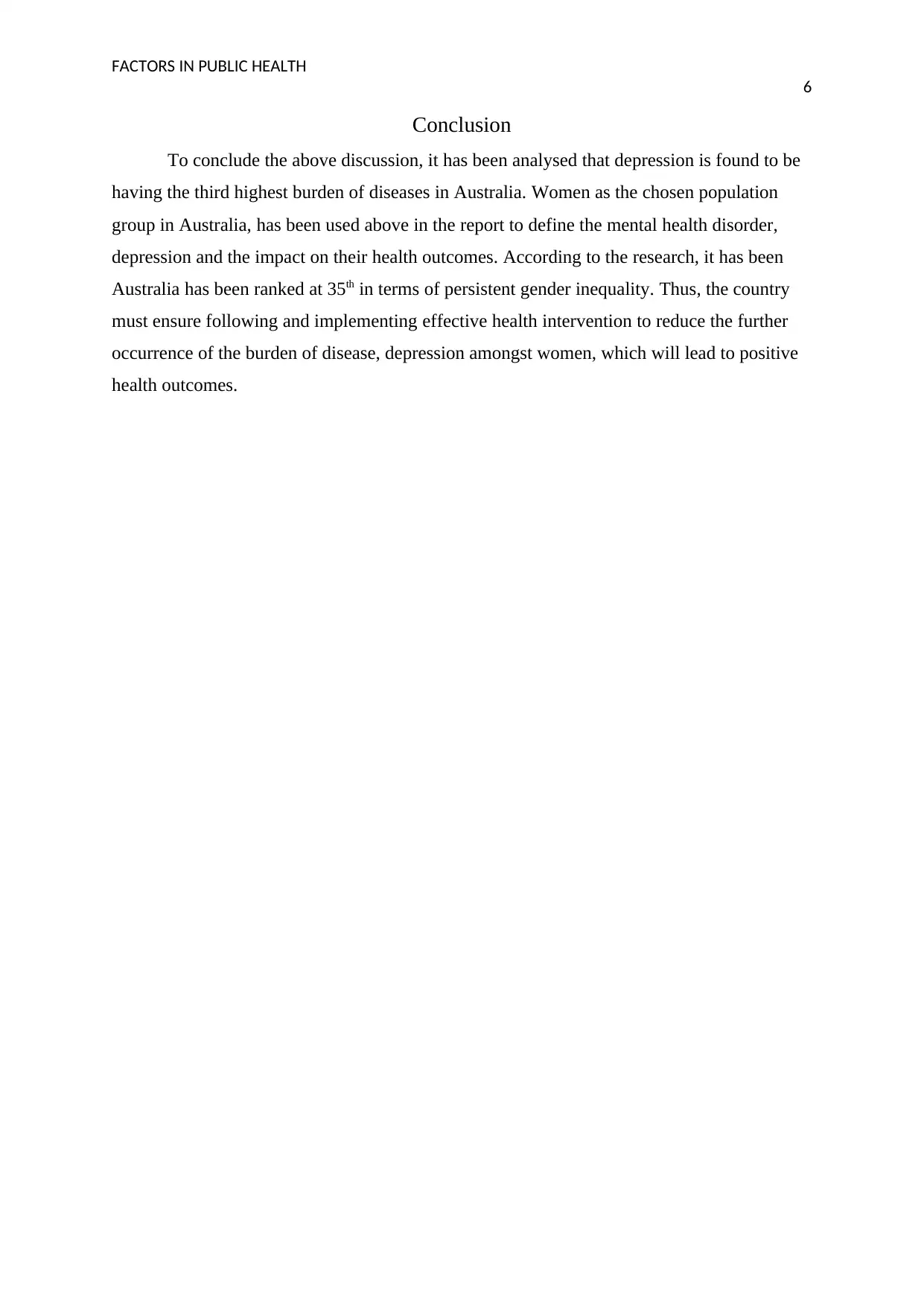
FACTORS IN PUBLIC HEALTH
6
Conclusion
To conclude the above discussion, it has been analysed that depression is found to be
having the third highest burden of diseases in Australia. Women as the chosen population
group in Australia, has been used above in the report to define the mental health disorder,
depression and the impact on their health outcomes. According to the research, it has been
Australia has been ranked at 35th in terms of persistent gender inequality. Thus, the country
must ensure following and implementing effective health intervention to reduce the further
occurrence of the burden of disease, depression amongst women, which will lead to positive
health outcomes.
6
Conclusion
To conclude the above discussion, it has been analysed that depression is found to be
having the third highest burden of diseases in Australia. Women as the chosen population
group in Australia, has been used above in the report to define the mental health disorder,
depression and the impact on their health outcomes. According to the research, it has been
Australia has been ranked at 35th in terms of persistent gender inequality. Thus, the country
must ensure following and implementing effective health intervention to reduce the further
occurrence of the burden of disease, depression amongst women, which will lead to positive
health outcomes.
Paraphrase This Document
Need a fresh take? Get an instant paraphrase of this document with our AI Paraphraser
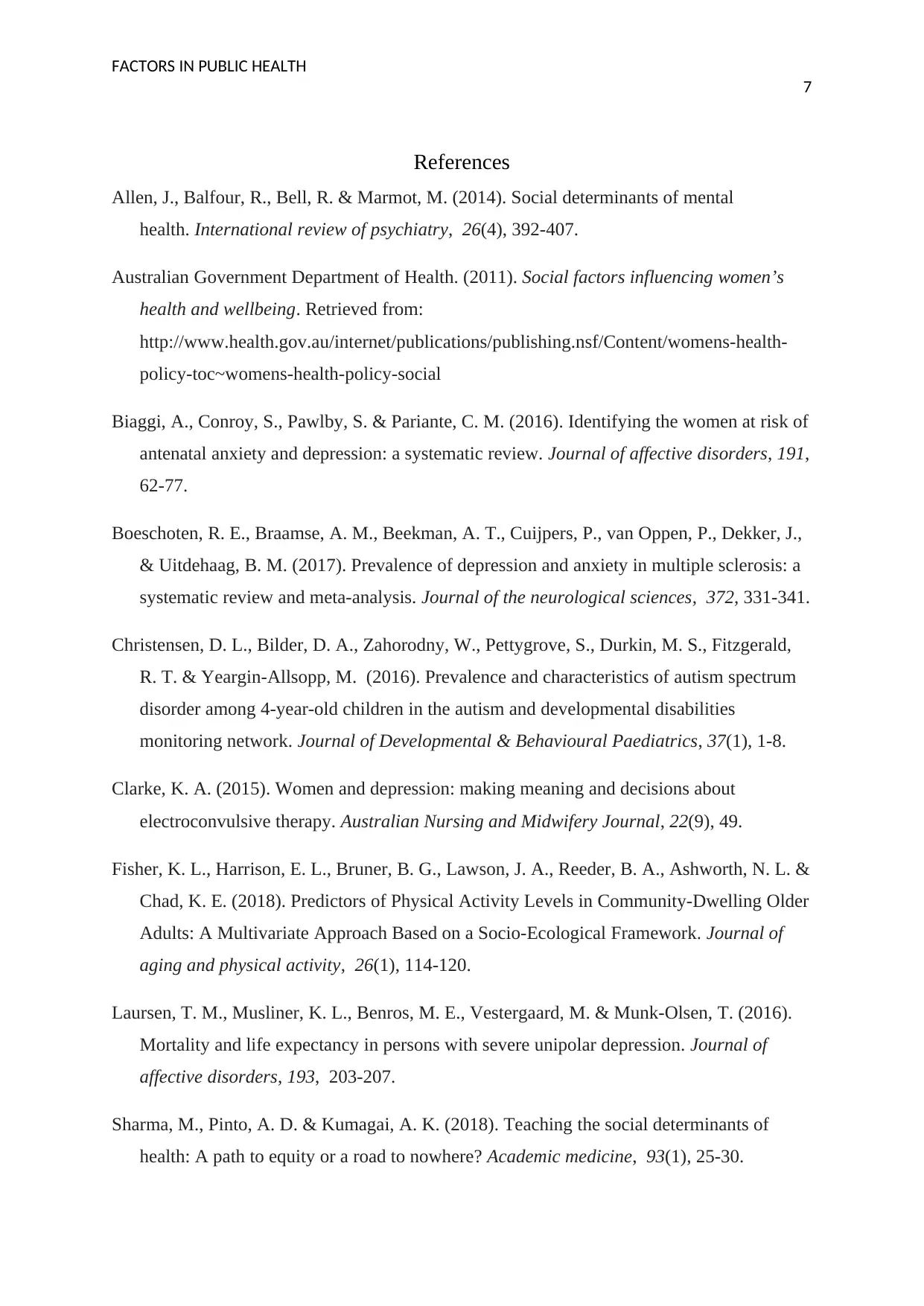
FACTORS IN PUBLIC HEALTH
7
References
Allen, J., Balfour, R., Bell, R. & Marmot, M. (2014). Social determinants of mental
health. International review of psychiatry, 26(4), 392-407.
Australian Government Department of Health. (2011). Social factors influencing women’s
health and wellbeing. Retrieved from:
http://www.health.gov.au/internet/publications/publishing.nsf/Content/womens-health-
policy-toc~womens-health-policy-social
Biaggi, A., Conroy, S., Pawlby, S. & Pariante, C. M. (2016). Identifying the women at risk of
antenatal anxiety and depression: a systematic review. Journal of affective disorders, 191,
62-77.
Boeschoten, R. E., Braamse, A. M., Beekman, A. T., Cuijpers, P., van Oppen, P., Dekker, J.,
& Uitdehaag, B. M. (2017). Prevalence of depression and anxiety in multiple sclerosis: a
systematic review and meta-analysis. Journal of the neurological sciences, 372, 331-341.
Christensen, D. L., Bilder, D. A., Zahorodny, W., Pettygrove, S., Durkin, M. S., Fitzgerald,
R. T. & Yeargin-Allsopp, M. (2016). Prevalence and characteristics of autism spectrum
disorder among 4-year-old children in the autism and developmental disabilities
monitoring network. Journal of Developmental & Behavioural Paediatrics, 37(1), 1-8.
Clarke, K. A. (2015). Women and depression: making meaning and decisions about
electroconvulsive therapy. Australian Nursing and Midwifery Journal, 22(9), 49.
Fisher, K. L., Harrison, E. L., Bruner, B. G., Lawson, J. A., Reeder, B. A., Ashworth, N. L. &
Chad, K. E. (2018). Predictors of Physical Activity Levels in Community-Dwelling Older
Adults: A Multivariate Approach Based on a Socio-Ecological Framework. Journal of
aging and physical activity, 26(1), 114-120.
Laursen, T. M., Musliner, K. L., Benros, M. E., Vestergaard, M. & Munk-Olsen, T. (2016).
Mortality and life expectancy in persons with severe unipolar depression. Journal of
affective disorders, 193, 203-207.
Sharma, M., Pinto, A. D. & Kumagai, A. K. (2018). Teaching the social determinants of
health: A path to equity or a road to nowhere? Academic medicine, 93(1), 25-30.
7
References
Allen, J., Balfour, R., Bell, R. & Marmot, M. (2014). Social determinants of mental
health. International review of psychiatry, 26(4), 392-407.
Australian Government Department of Health. (2011). Social factors influencing women’s
health and wellbeing. Retrieved from:
http://www.health.gov.au/internet/publications/publishing.nsf/Content/womens-health-
policy-toc~womens-health-policy-social
Biaggi, A., Conroy, S., Pawlby, S. & Pariante, C. M. (2016). Identifying the women at risk of
antenatal anxiety and depression: a systematic review. Journal of affective disorders, 191,
62-77.
Boeschoten, R. E., Braamse, A. M., Beekman, A. T., Cuijpers, P., van Oppen, P., Dekker, J.,
& Uitdehaag, B. M. (2017). Prevalence of depression and anxiety in multiple sclerosis: a
systematic review and meta-analysis. Journal of the neurological sciences, 372, 331-341.
Christensen, D. L., Bilder, D. A., Zahorodny, W., Pettygrove, S., Durkin, M. S., Fitzgerald,
R. T. & Yeargin-Allsopp, M. (2016). Prevalence and characteristics of autism spectrum
disorder among 4-year-old children in the autism and developmental disabilities
monitoring network. Journal of Developmental & Behavioural Paediatrics, 37(1), 1-8.
Clarke, K. A. (2015). Women and depression: making meaning and decisions about
electroconvulsive therapy. Australian Nursing and Midwifery Journal, 22(9), 49.
Fisher, K. L., Harrison, E. L., Bruner, B. G., Lawson, J. A., Reeder, B. A., Ashworth, N. L. &
Chad, K. E. (2018). Predictors of Physical Activity Levels in Community-Dwelling Older
Adults: A Multivariate Approach Based on a Socio-Ecological Framework. Journal of
aging and physical activity, 26(1), 114-120.
Laursen, T. M., Musliner, K. L., Benros, M. E., Vestergaard, M. & Munk-Olsen, T. (2016).
Mortality and life expectancy in persons with severe unipolar depression. Journal of
affective disorders, 193, 203-207.
Sharma, M., Pinto, A. D. & Kumagai, A. K. (2018). Teaching the social determinants of
health: A path to equity or a road to nowhere? Academic medicine, 93(1), 25-30.
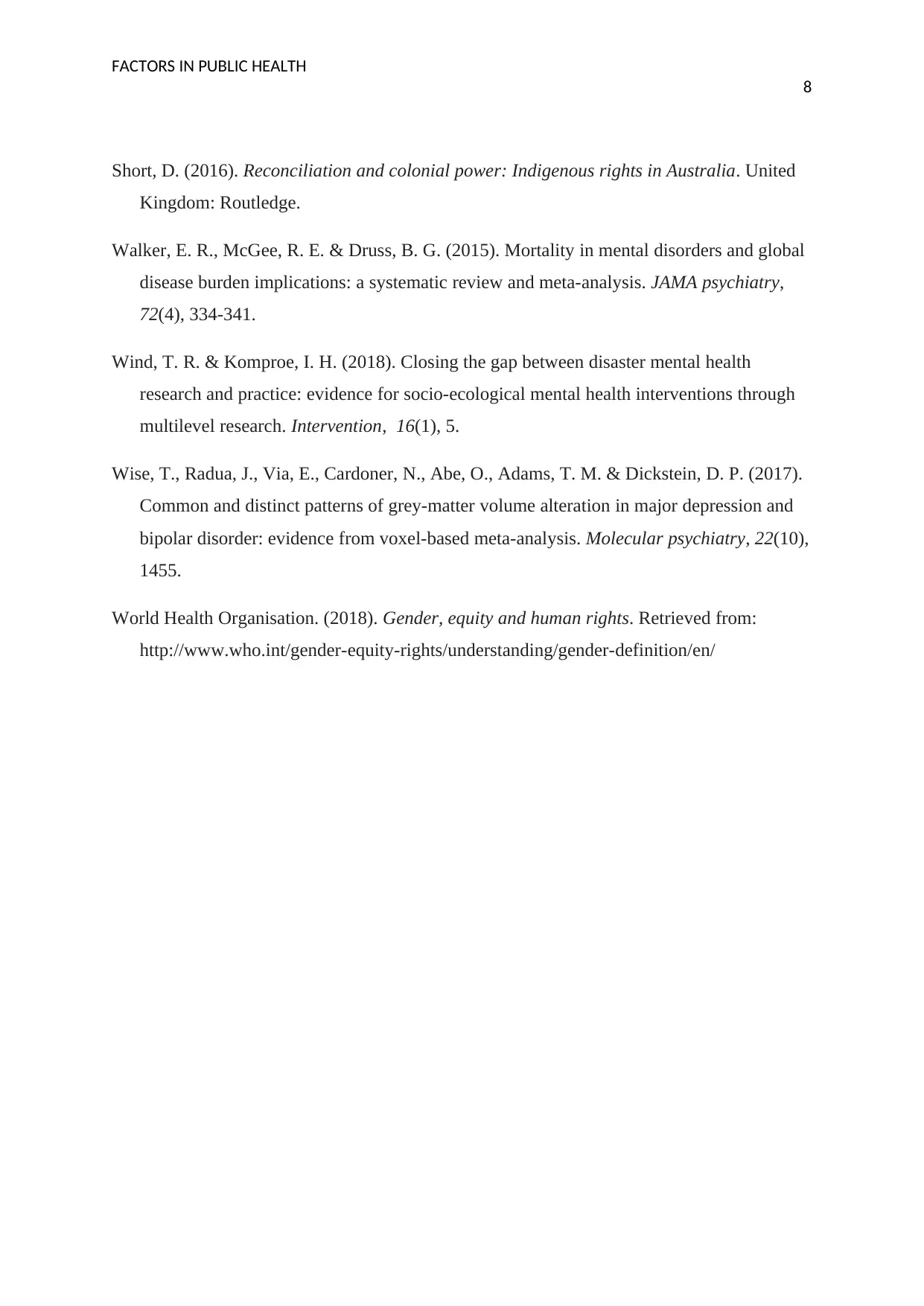
FACTORS IN PUBLIC HEALTH
8
Short, D. (2016). Reconciliation and colonial power: Indigenous rights in Australia. United
Kingdom: Routledge.
Walker, E. R., McGee, R. E. & Druss, B. G. (2015). Mortality in mental disorders and global
disease burden implications: a systematic review and meta-analysis. JAMA psychiatry,
72(4), 334-341.
Wind, T. R. & Komproe, I. H. (2018). Closing the gap between disaster mental health
research and practice: evidence for socio-ecological mental health interventions through
multilevel research. Intervention, 16(1), 5.
Wise, T., Radua, J., Via, E., Cardoner, N., Abe, O., Adams, T. M. & Dickstein, D. P. (2017).
Common and distinct patterns of grey-matter volume alteration in major depression and
bipolar disorder: evidence from voxel-based meta-analysis. Molecular psychiatry, 22(10),
1455.
World Health Organisation. (2018). Gender, equity and human rights. Retrieved from:
http://www.who.int/gender-equity-rights/understanding/gender-definition/en/
8
Short, D. (2016). Reconciliation and colonial power: Indigenous rights in Australia. United
Kingdom: Routledge.
Walker, E. R., McGee, R. E. & Druss, B. G. (2015). Mortality in mental disorders and global
disease burden implications: a systematic review and meta-analysis. JAMA psychiatry,
72(4), 334-341.
Wind, T. R. & Komproe, I. H. (2018). Closing the gap between disaster mental health
research and practice: evidence for socio-ecological mental health interventions through
multilevel research. Intervention, 16(1), 5.
Wise, T., Radua, J., Via, E., Cardoner, N., Abe, O., Adams, T. M. & Dickstein, D. P. (2017).
Common and distinct patterns of grey-matter volume alteration in major depression and
bipolar disorder: evidence from voxel-based meta-analysis. Molecular psychiatry, 22(10),
1455.
World Health Organisation. (2018). Gender, equity and human rights. Retrieved from:
http://www.who.int/gender-equity-rights/understanding/gender-definition/en/
1 out of 9
Related Documents
Your All-in-One AI-Powered Toolkit for Academic Success.
+13062052269
info@desklib.com
Available 24*7 on WhatsApp / Email
![[object Object]](/_next/static/media/star-bottom.7253800d.svg)
Unlock your academic potential
© 2024 | Zucol Services PVT LTD | All rights reserved.





